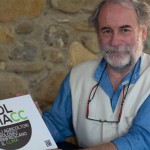Farm description
Mannucci Droandi is a family farm located in the hamlet named Caposelvi, about 35 km far from Arezzo.
The production is based mainly on olive oil and wine according to the standards of organic farming. The C.G.D.O. (Controlled and Guaranteed Denomination of Origin) “Chianti Colli Aretini” and the T.G.I. (Typical Geographical Indication) “Barsaglina” are included among the fine wines of the company. The olive oil produced is the Extra Virgin Olive Oil D.P.O. (Denomination of Protected Origin) “Chianti Classico” .
The farm consists of two areas: Campolucci and Ceppeto. The former is located on the eastern slopes of the Chianti Mountains at an altitude of 250 m above sea level. It has been owned by the Mannucci Droandi family since 1929 and it is composed by a large farmhouse hosting the corporate center and the cellar, different fields alternating with forests of oaks, pines and oaks. Around 1970, the owner (Roberto Giulio Droandi)’s parents planted for the first time specialized vineyards and olive groves.
The second part of the estate, Ceppeto, consists of vineyards and olive groves planted around a large, square stone farmhouse and surrounded by dense oak and chestnut woodland. It is situated on the west side of the Chianti mountains at 350 m above sea level.
Roberto Droandi and his wife Maria Grazia Mammuccini consider the product quality the crucial aim of their way of working. They were able to adapt the mindset of the farm to high standards of production through huge investments in equipment, in state-of-the-art machinery and in modernization works of the processing plants and through the collaboration of qualified experts (enologists and agronomists).
Furthermore, they are committed to develop an eco-friendly viticulture. In order to reduce the use of anti-weed, anti-parasitic and chemically-derived fertilizers, the company have collaborated for about ten years with the “Istituto Sperimentale per la Viticoltura” (Section of Arezzo) of the Agriculture and Forestry Policies Ministry. Specifically, they are involved in some projects aimed at the development of methods for monitoring and fighting against fungal or parasitic weeds and have contributed to the building of an experimental vineyard collecting vine varieties at risk of extinction in order to guarantee the “Preservation of grapevine germplasm of Arezzo area” (as stated in the Regional Authorization of Tuscany). The farm is located in a hilly area characterised by wine and olive oil production. The farmer works on biodiversity conservation, growing varieties that are at risk to be lost (foglia tonda, barsaglina, pugnitello).
To learn more, please visit the farm’s website http://www.mannuccidroandi.com/
Climate friendly practices applied
1. Optimized nutrient management
Improved composting of on-farm residues
The main aim of the implementation plan in this farm is to introduce the compost of on-farm residues from wine production and vineyards management. For this, the farmer started to produce a compost from the vine production residues (around 1500 – 2000 kg/year) and small branches of wine trees. A composting machine was bought. The compost is turned 2 or 3 times per year.
Composting wine production residues helps to reduce CH4 and N2O emissions, compared to the emissions of a residue pile. Additionally, compost application helps to reduce fertilizer application in the following years.
2. Optimized crop rotation management
Introduction of forage legumes
The farm introduced green manure with seeding, in the vineyards and olive groove on 31 ha. The green manure consists of different graminacea, bee pasture (Phacelia) and clover. It is cut 3-5 times a year and utilized for the compost production or directly left on the field as a fertilizer for the vineyards.
Legume crops contribute to N fixation and therefore reduce the amount of fertilizers needed in the following years.
3. Optimized tillage management systems
Reduced tillage
Farm avoids ploughing and introduces a ploughless cultivation techniques on the 31 ha (olives and vineyards). Instead, a permanent grass cover is cultivated with 2-4 passages per year with spring harrows or disks that are used to aerate the soil.
By employing these practices diesel consumption will be reduced.
4. Agroforestry
Diversifying the existing tree crops
The farm consists of 8 ha olive groves, 25 ha vineyards and around 1 ha boundary trees along the fields. The boundary trees were diversified and new trees were planted (e.g. Robinia and Oak).
Together, the trees sequester above- and belowground C in the tree biomass and soil.Additionally, the boundary trees support a rich natural biodiversity in the border of the fields. Another interesting element of innovation that this farm will introduce is the presence of chicken in the vineyard. The number of animals, limited by the organic regulation (834/07) is not sufficient to contribute in nutrient recycling. However, the choice of a race at risk of extinction makes this action to improve the farm biodiversity conservation.
Special credit goes to Klaus-Peter Wilbois for the photographs published in this page.
Location
Other farms
